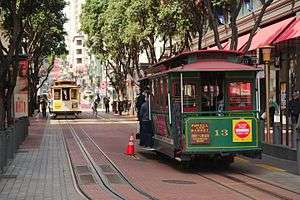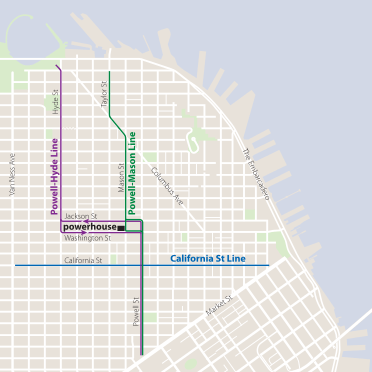San Francisco cable car system
|
Cable Car No. 13 on Powell Street | |||
| Overview | |||
|---|---|---|---|
| Owner | San Francisco Municipal Transportation Agency | ||
| Area served | Chinatown, Financial District, Fisherman's Wharf, Nob Hill, Russian Hill, Union Square | ||
| Locale | San Francisco | ||
| Transit type | Cable car | ||
| Number of lines | 3 | ||
| Line number |
59 Powell-Mason 60 Powell-Hyde 61 California St. | ||
| Number of stations | 62 | ||
| Daily ridership | 20,100 (2014)[1] | ||
| Annual ridership | 7,409,400 (2014)[1] | ||
| Headquarters | San Francisco Cable Car Museum | ||
| Website | sfmta.com | ||
| Operation | |||
| Began operation |
California St. line: 1878 Powell-Mason line: 1888 Powell-Hyde line: 1957[2][3] | ||
| Operator(s) | San Francisco Municipal Railway | ||
| Reporting marks | MUNI | ||
| Character | Street running with some reserved right-of-ways | ||
| Number of vehicles |
California St. line: 12 double-ended cars Powell-Mason/Hyde lines: 28 single-ended cars | ||
| Train length | 1 grip car | ||
| Technical | |||
| System length |
California St. line: 1.4 mi (2.3 km) Powell-Mason line: 1.6 mi (2.6 km) Powell-Hyde line: 2.1 mi (3.4 km) | ||
| No. of tracks | 2 | ||
| Track gauge | 3 ft 6 in (1,067 mm) | ||
| Top speed | 9.5 mph (15.3 km/h) | ||
| |||
|
San Francisco Cable Cars | |
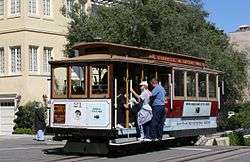 Powell-Hyde line cable car crossing Lombard Street on Russian Hill | |
| Location | 1390 Washington Street, San Francisco |
|---|---|
| Coordinates | 37°47′44″N 122°24′27″W / 37.79556°N 122.40750°WCoordinates: 37°47′44″N 122°24′27″W / 37.79556°N 122.40750°W |
| Built | 1873 |
| Architect | Andrew Smith Hallidie[4] |
| NRHP Reference # | 66000233[5] |
| Significant dates | |
| Added to NRHP | October 15, 1966 |
| Designated NHL | January 29, 1964[6] |
San Francisco cable car system | ||||||||||||||||||||||||||||||||||||||||||||||||||||||||||||||||||||||||||||||||||||||||||||||||||||||||||||||||||||||||||||||||||||||||||||||||||||||||||||||||||||||||||||||||||||||||||||||||||||||||||||||||||||||||||||||||||||||||||||||||||||||||||||||||||||||||||||||||||||||||||||||||||||||||||||||||||||||||||||||||||||||||||
|---|---|---|---|---|---|---|---|---|---|---|---|---|---|---|---|---|---|---|---|---|---|---|---|---|---|---|---|---|---|---|---|---|---|---|---|---|---|---|---|---|---|---|---|---|---|---|---|---|---|---|---|---|---|---|---|---|---|---|---|---|---|---|---|---|---|---|---|---|---|---|---|---|---|---|---|---|---|---|---|---|---|---|---|---|---|---|---|---|---|---|---|---|---|---|---|---|---|---|---|---|---|---|---|---|---|---|---|---|---|---|---|---|---|---|---|---|---|---|---|---|---|---|---|---|---|---|---|---|---|---|---|---|---|---|---|---|---|---|---|---|---|---|---|---|---|---|---|---|---|---|---|---|---|---|---|---|---|---|---|---|---|---|---|---|---|---|---|---|---|---|---|---|---|---|---|---|---|---|---|---|---|---|---|---|---|---|---|---|---|---|---|---|---|---|---|---|---|---|---|---|---|---|---|---|---|---|---|---|---|---|---|---|---|---|---|---|---|---|---|---|---|---|---|---|---|---|---|---|---|---|---|---|---|---|---|---|---|---|---|---|---|---|---|---|---|---|---|---|---|---|---|---|---|---|---|---|---|---|---|---|---|---|---|---|---|---|---|---|---|---|---|---|---|---|---|---|---|---|---|---|---|---|---|---|---|---|---|---|---|---|---|---|---|---|---|---|---|---|---|---|---|---|---|---|---|---|---|---|---|---|---|---|---|---|---|---|---|---|---|---|---|---|---|---|---|---|---|---|---|---|
| Modern system | ||||||||||||||||||||||||||||||||||||||||||||||||||||||||||||||||||||||||||||||||||||||||||||||||||||||||||||||||||||||||||||||||||||||||||||||||||||||||||||||||||||||||||||||||||||||||||||||||||||||||||||||||||||||||||||||||||||||||||||||||||||||||||||||||||||||||||||||||||||||||||||||||||||||||||||||||||||||||||||||||||||||||||
| ||||||||||||||||||||||||||||||||||||||||||||||||||||||||||||||||||||||||||||||||||||||||||||||||||||||||||||||||||||||||||||||||||||||||||||||||||||||||||||||||||||||||||||||||||||||||||||||||||||||||||||||||||||||||||||||||||||||||||||||||||||||||||||||||||||||||||||||||||||||||||||||||||||||||||||||||||||||||||||||||||||||||||
The San Francisco cable car system is the world's last manually operated cable car system. An icon of San Francisco, the cable car system forms part of the intermodal urban transport network operated by the San Francisco Municipal Railway. Of the 23 lines established between 1873 and 1890,[7] only three remain (one of which combines parts of two earlier lines): two routes from downtown near Union Square to Fisherman's Wharf, and a third route along California Street. While the cable cars are used to a certain extent by commuters, the vast majority of their 7 million annual passengers are tourists.[8] They are among the most significant tourist attractions in the city, along with Alcatraz Island, the Golden Gate Bridge, and Fisherman's Wharf. The cable cars are listed on the National Register of Historic Places.[5]
The cable cars are not to be confused with San Francisco's heritage streetcars, which operate on Market Street and the Embarcadero.
History
Beginnings
In 1869, Andrew Smith Hallidie had the idea for a cable car system in San Francisco, reportedly after witnessing an accident where a streetcar drawn by horses over wet cobblestones slid backwards, killing the horses.[9]
The first successful cable-operated street railway was the Clay Street Hill Railroad, which opened on August 2, 1873. The promoter of the line was Hallidie, and the engineer was William Eppelsheimer. The line involved the use of grip cars, which carried the grip that engaged with the cable, towing trailer cars; the design was the first to use grips. The term "grip" became synonymous with the operator.
The line started regular service on September 1, 1873, and its success led it to become the template for other cable car transit systems. It was a financial success, and Hallidie's patents were enforced on other cable car promoters, making him wealthy.
Accounts differ as to exactly how involved Hallidie was in the inception of the line, and to the exact date it first ran.
Expansion
The next cable car line to open was the Sutter Street Railway, which converted from horse operation in 1877. This line introduced the side grip, and lever operation, both designed by Henry Casebolt and his assistant Asa Hovey, and patented by Henry Casebolt. This idea was brought about because Casebolt did not want to pay Hallidie royalties of $50,000 a year for use of his patent. The side grip allowed cable cars to cross at intersections.
In 1878, Leland Stanford opened his California Street Cable Railroad (Cal Cable). This company's first line was on California Street and is the oldest cable car line still in operation. In 1880, the Geary Street, Park & Ocean Railway began operation. The Presidio and Ferries Railway followed two years later, and was the first cable company to include curves on its routes. The curves were "let-go" curves, where the car drops the cable and coasts around the curve on its own momentum.
In 1883, the Market Street Cable Railway opened its first line. This company was controlled by the Southern Pacific Railroad and was to grow to become San Francisco's largest cable car operator. At its peak, it operated five lines all of which converged into Market Street to a common terminus at the Ferry Building. During rush hours, cars left that terminus every 15 seconds.[10]
In 1888, the Ferries and Cliff House Railway opened its initial two-line system. The Powell-Mason line is still operated on the same route today; their other route was the Powell-Washington-Jackson line, stretches of which are used by today's Powell-Hyde line. The Ferries & Cliff House Railway was also responsible for the building of a car barn and powerhouse at Washington and Mason, and this site is still in use today. In the same year, it also purchased the original Clay Street Hill Railway, which it incorporated into a new Sacramento-Clay line in 1892.
In 1889, the Omnibus Railroad and Cable Company was the last new cable car operator in San Francisco. The following year the California Street Cable Railroad opened two new lines, these being the last entirely new cable car lines built in the city. One of them was the O'Farrell-Jones-Hyde line, the Hyde section of which still remains in operation as part of the current Powell-Hyde line.
In all, twenty-three lines were established between 1873 and 1890.[7]
Decline

The first electric streetcars in San Francisco began operation in 1892 under the auspices of the San Francisco and San Mateo Electric Railway. At that time, it was estimated that it cost twice as much to build and six times as much to operate a line with cable cars as with electric streetcars.
By the beginning of 1906 many of San Francisco's remaining cable cars were under the control of the United Railroads of San Francisco (URR), although Cal Cable and the Geary Street Company remained independent. URR was pressing to convert many of its cable lines to overhead electric traction, but this was being resisted by opponents who objected to what they saw as ugly overhead lines on the major thoroughfares of the city center.
Those objections disappeared after the 1906 San Francisco earthquake. The quake and resulting fire destroyed the power houses and car barns of both the Cal Cable and the URR's Powell Street lines, together with the 117 cable cars stored within them. The subsequent race to rebuild the city allowed the URR to replace most of its cable car lines with electric streetcar lines. At the same time the independent Geary Street line was replaced by a municipally owned electric streetcar line, the first line of the San Francisco Municipal Railway (Muni).
By 1912, only eight cable car lines remained, all with steep gradients impassable to electric streetcars. In the 1920s and 1930s, these lines came under pressure from the much improved buses of the era, which could now climb steeper hills than the electric streetcar. By 1944, the only cable cars remaining were the two Powell Street lines – by then in municipal ownership, as part of Muni – and the three lines owned by the still-independent Cal Cable.
Fight-back
In 1947, Mayor Roger Lapham proposed the closure of the two municipally owned lines. In response, a joint meeting of 27 women's civic groups, led by Friedel Klussmann, formed the Citizens' Committee to Save the Cable Cars. In a famous battle of wills, the citizens' committee eventually forced a referendum on an amendment to the city charter, compelling the city to continue operating the Powell Street lines. This passed overwhelmingly, by 166,989 votes to 51,457.
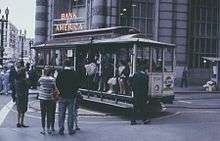
In 1951, the three Cal Cable lines were shut down when the company was unable to afford insurance. The city purchased and reopened the lines in 1952, but the amendment to the city charter did not protect them, and the city proceeded with plans to replace them with buses. Again Klussmann came to the rescue, but with less success. The result was a compromise that formed the current system: a protected system made up of the California Street line from Cal Cable, the Powell-Mason line already in municipal ownership, and a third hybrid line formed by grafting the Hyde Street section of Cal Cable's O'Farrell-Jones-Hyde line onto a truncated Powell-Washington-Jackson line, now known as the Powell-Hyde line.
This solution required some rebuilding to convert the Hyde Street trackage and terminus to operation by the single-ended cars of the Powell line, and also to allow the whole system to be operated from a single car barn and power house. Much of the infrastructure remained unchanged from the time of the earthquake.
Rebuild
By 1979, the cable car system had become unsafe, and it needed to be closed for seven months for urgently needed repairs. A subsequent engineering evaluation concluded that it needed comprehensive rebuilding at a cost of $60 million.[11] Mayor Dianne Feinstein took charge of the effort, and helped win federal funding for the bulk of the rebuilding job. In 1982 the cable car system was closed again for a complete rebuild. This involved the complete replacement of 69 city blocks' worth of tracks and cable channels, the complete rebuilding of the car barn and powerhouse within the original outer brick walls, new propulsion equipment, and the repair or rebuild of 37 cable cars.[11] The system reopened on June 21, 1984, in time to benefit from the publicity that accompanied San Francisco's hosting of that year's Democratic National Convention.[11]

Recent history
Since 1984, Muni has continued to upgrade the system. Work has included rebuilding of another historical car, the building of nine brand new replacement cars, the building of a new terminal and turntable at the Hyde and Beach terminus, and a new turntable at the Powell and Market terminus.
The cable cars are principally used by tourists rather than commuters.[8] The system serves an area of the city that is already served by a large number of buses and trolleybuses. The two lines on Powell Street (Powell-Hyde and Powell-Mason) both serve only residential and tourist/shopping districts (Union Square, Chinatown, North Beach, Nob Hill, Aquatic Park and Fisherman's Wharf), with the "downtown" end of both lines a substantial distance from the Financial District. The California Street Line is used more by commuters, due to its terminus in the Financial District.
In 2006, then-mayor Gavin Newsom reported that he had observed several conductors pocketing cash fares from riders without receipt.[12] The following year, the San Francisco auditor's office reported that the city was not receiving the expected revenue from cable cars, with an estimated 40% of cable car riders riding for free. Muni's management disputed this figure, and pointed out that safe operation, rather than revenue collection, is the primary duty of conductors.[13] In 2017, after an audit showing that some conductors were "consistently turn[ing] in low amounts of cash" and a sting operation, one conductor was arrested on charges of felony embezzlement.[12]
The US Department of Transportation counts the cable cars among the mass transportation systems with the most accidents per year and vehicle mile in the US, with 126 accidents and 151 injured persons reported by the city during the 10 years until 2013.[8] Records obtained by the Associated Press in 2013 showed that over the course of three years, the city of San Francisco had paid almost $8 million to settle around four dozen legal claims relating to cable car accidents.[8]
Operation
_-_detail.jpg)
.jpg)


Cables and grip
The cable cars are pulled by a cable running below the street, held by a grip that extends from the car through a slit in the street surface, between the rails.[14] Each cable is 1.25 inches (3.2 cm) in diameter, running at a constant speed of 9.5 miles per hour (15.3 km/h), and driven by a 510 horsepower (380 kW) electric motor located in the central power house (see below), via a set of self-adjusting sheaves.[14] Each cable has six steel strands, with each strand containing 19 wires, wrapped around a sisal rope core[14] (to allow easier gripping). The cables are coated with a tar-like material which serves as a sacrificial lubricant - much like a pencil eraser erodes away rather than the paper.[14] To start and stop the movement of the car, the gripman (see below) closes and opens the grip around the cable (similar to the clutch of a conventional car).[14] The grip's jaws exert a pressure of up to 30,000 pounds per square inch (210,000 kPa) on the cable.[14]
There are four separate cables: one 16,000-foot (4,900 m) length and one 10,300-foot (3,100 m) length for the Hyde and Mason segments, a 9,300-foot (2,800 m) length for their common Powell section, and one 21,000-foot (6,400 m) length for the California Street line.[14]
Brakes

Apart from the cable itself (which exerts a braking force when going downhill), the cable cars use three separate braking systems:[15]
- Metal brake shoes on the front and back wheels, which the gripman can operate via a pedal located next to the grip. On the Powell-Mason line, they can also be activated by the conductor, via a lever at the back of the car.[15]
- Wooden brake blocks between the wheels that are pressed against the track when the gripman pulls a lever, bringing the car to a halt.[9] The four blocks are made of Douglas fir (pine) and can produce a smell of burning wood when in operation.[9] They have to be replaced after just a few days.[15]
- An emergency brake consisting of a piece of steel, around 1.5 inches thick and 18 inches long, which hangs under the car and is pushed into the track slot (the opening through which the grip reaches the cable) when the gripman pulls a lever.[15] It wedges tightly into the slot and often has to be removed with a welding torch.[15]
Network
The current cable car network consists of three routes. Like all Municipal Railway (Muni) routes which have route letters or numbers, the cable lines have route numbers, but the cable routes are generally referred to by the names of the streets on which they travel. The Powell-Hyde and Powell-Mason lines use "single-ended" cars, which must be looped or turned around like a bus at the end of the line; the single-ended cable cars use manual non-powered turntables to rotate the car. There are three street turntables to do this, one at the end of each of the three terminals: at Market & Powell Streets, Taylor & Bay Streets, and Hyde & Beach Streets, with a fourth turntable located inside the car barn on Washington and Jackson Streets.
- The Powell-Mason (Line 59)[16] line shares the tracks of the Powell-Hyde line as far as Mason Street, where it crosses Washington and Jackson Streets. Here the line turns right and downhill along Mason Street, briefly half left along Columbus Avenue, and then down Taylor Street to a terminal at Taylor and Bay. This terminus is near to but two blocks back from the waterfront at Fisherman's Wharf. As with the Powell-Hyde, there are manually-powered turntables at each end to reverse the cars. This line is also used greatly by tourists, but also some commuters.
- The Powell-Hyde (Line 60)[16] line runs north and steeply uphill from a terminal at Powell and Market Streets, before crossing the California Street line at the crest of the hill. Downhill from this crest it turns left and uphill again along Jackson Street (as this is one-way, cable cars in the opposite direction use the parallel Washington Street), to a crest at Hyde Street. Here it turns right and steeply downhill along Hyde Street to the Hyde and Beach terminal, which is adjacent to the waterfront at the San Francisco Maritime Museum. The line was spliced together using remnant portions of the O'Farrell, Jones & Hyde line and the Washington-Jackson line. Manually-powered turntables turn the cable cars around at the two ends. This line is used greatly by tourists and often has long queues.
- The California Street (Line 61)[16] line runs east and west on California Street from a terminal at California and Market Streets, close to the famed Embarcadero to Van Ness Avenue. The California street cable-cars use double-ended cars with "grip" levers at either end of the longer cars which are operated in each direction without the cars being turned at the ends of the line, where the double tracks converge into a single "stub-end" track. The line once ran a much longer distance from Presidio Avenue to Market Street but service west of Van Ness Avenue was discontinued in 1954.[17][18] Calls to restore the route to its original length are heard from time to time but nothing serious towards this end has been proposed. This route runs only on California Street, running at first uphill to the summit of Nob Hill, then more gently downhill to a terminus at Van Ness Avenue. This line is used to a greater extent by commuters, with majority of passengers on weekdays being commuters.
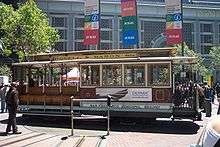
There is also a set of non-revenue tracks from the California Street line along Hyde Street to join the Powell-Hyde line at Hyde and Washington. This connection exists to enable California Street cars to reach the car barn.
The cable car system connects at both its terminals on Market Street with the F Market heritage streetcar line. The Taylor and Bay terminal, and the Hyde and Beach terminal, are both short walks from the F Market line.
Fares and revenues

As of July 1, 2015, riding a cable car costs $7 for a single ride, except for seniors riding before 7am or after 9pm when the senior fare is $3. $7 Cable Car Souvenir Tickets are sold in advance and include a San Francisco souvenir as well as a single ride. Beside these single ride tickets, cable car rides are included in monthly Muni passes, as well as 1-day, 3-day, 7-day passes, and the CityPASS program. Passes loaded on a Clipper card can be read by the conductor with a mobile device. Transfers or fare receipts are not accepted.[19] In the 1960s, the fare for a single ride was 15 cent.[12]
In budget year 2012, sales of $6 Cable Car Souvenir Tickets totaled $4,125,386. $6 single rider tickets sold by the cable car conductors totaled $9,888,001.[20] Based on both tickets only, daily ridership of the cable car system was more than 6400. By 2017, the San Francisco Chronicle described the cable cars as a "cash cow" for Muni, yielding a yearly revenue of around $30 million.[12]
Cars

- Single-ended cars serve the Powell-Hyde and Powell-Mason lines. These cars have an open-sided front section, with outward-facing seats flanking the gripman and a collection of levers that actuate the grip and various brakes. The rear half of the car is enclosed, with seats facing inward and entrances at each end and the car has a small platform at the rear. These cars are 27 feet 6 inches (8.4 m) long and 8 feet (2.4 m) wide and weigh 15,500 pounds (7,000 kg). They have a passenger capacity of 60, 29 of them seated.[21] These cars must be rotated to reverse direction at each end of the line, an operation performed on turntables. Most of these cars were built or rebuilt in the 1990s at Muni's Woods Carpentry Division.
- Double-ended cars serve the California Street line. These cars are somewhat longer, having open-sided grip sections at both ends and an enclosed section in the middle. These cars are 30 feet 3 inches (9.2 m) long and 8 feet (2.4 m) wide and weigh 16,800 pounds (7,600 kg). They can hold 68 passengers, 34 of them seated.[22] The California Street line lacks turning capabilities at each end, resulting in the necessity of the double-ended cars. Some of these cars are genuine former O'Farrell, Jones, and Hyde Street cable cars, while some of these cable cars were built in 1998 at Muni's Woods Division/Woods Carpentry Division.
Both types of car ride on a pair of four-wheel trucks, to fit the track's 3 ft 6 in (1,067 mm) narrow gauge. The term California Street car, as in a car running on the California Street line, should not be confused with the term California Car. The latter term applies to all the cable cars currently operating in San Francisco, and is a historical term distinguishing this style of car from an earlier style where the open grip section and the enclosed section were separate four-wheel cars (known as the grip car and trailer).
There are 28 single ended cars in operation on the Powell lines and 12 double ended cars in operation on the California Street line.[23] The cable cars are occasionally replaced with new or restored cars, with the old cars being moved to storage for later restoration. There are 2 cable cars in storage in the cable car museum / power house inside the garage, car numbers 19 and 42 which were used on the Sacramento-Clay and O'Farrell, Jones and Hyde Street lines, respectively.
Car barn, power house and museum
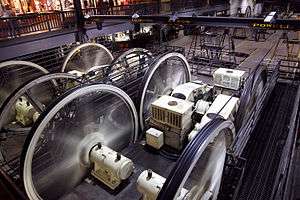
The car barn is located between Washington and Jackson Streets just uphill of where Mason Street crosses them. Cars reverse into the barn off Jackson Street and run out into Washington Street, coasting downhill for both moves. To ensure that single-ended cars leave facing in the correct direction, the car barn contains a fourth turntable. Cars are moved around the car barn with the assistance of a rubber-tired tractor.
The car barn is situated directly above the power house and the Cable Car Museum. The museum's entrance is at Washington and Mason. It contains several examples of old cable cars, together with smaller exhibits and a shop. Two galleries allow the visitor to overlook the main power house, and also to descend below the junction of Washington and Mason Streets and see the large cavern where the haulage cables are routed out to the street.
Gripmen and conductors
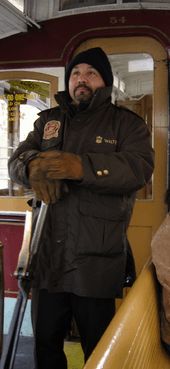
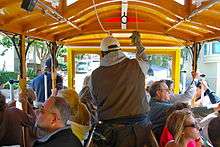
The driver of a cable car is known as the gripman or grip operator. This is a highly skilled job, requiring the gripman to smoothly operate the grip lever to grip and release the cable, release the grip at certain points to coast the vehicle over crossing cables or places where the cable does not follow the tracks, and to anticipate well in advance possible collisions with other traffic that may not understand the limitations of a cable car. Being a gripman requires great upper body strength needed for the grip and brakes, as well as good hand–eye coordination and balance.
As of August 2011, there have been two grip women, Fannie Mae Barnes, who served from 1998 to 2002, and Willa Johnson, who became a grip operator in April 2010.[24]
Besides the gripman, each cable car carries a conductor whose job is to collect fares, manage the boarding and exiting of passengers, and control the rear wheel brakes when descending hills. With the common practice of carrying standing passengers on the running boards of cable cars, passenger management is an important task.
Some crew members are locally well-known personalities.
Cable car bell-ringing contest
On the second or third Thursday each July, a cable car bell-ringing contest is held in Union Square between cable car crews, following a preliminary round held during the second to last or the last week of June. The preliminary round determines which contestants go on to the finals in Union Square, by a process of points awarded by a panel of judges.[25][26][27]
| Year | First place | Second place | Third place |
|---|---|---|---|
| 2002 | Ken Lunardi | Byron Cobb | Ronald East |
| 2003 | Ronald East | Ken Lunardi | Walter Scott, III |
| 2003 Invitational | Carl Payne | Al Quintana | Peter Pavlukevich |
| 2004 | Frank Ware | Walter Scott, III | Byron Cobb |
| 2005 | Byron Cobb | Frank Ware | Howard Woo |
| 2006 | Ken Lunardi | Byron Cobb | Warren Robinson III |
| 2007 | Leonard Oats | Ken Lunardi | Frank Ware |
| 2008 | Leonard Oats | Ken Lunardi | Byron Cobb |
| 2009 | Leonard Oats | Frank Ware | Howard Woo |
| 2010 | None[note 1] | ||
| 2011 | None[note 2] | ||
| 2012 | Trini Whittaker | Leonard Oats | Ken Lunardi |
| 2013 | Trini Whittaker | Ken Lunardi | Joseph Sue |
| 2014 | None | ||
| 2015 | Byron Cobb | Trini Whittaker | Leonard Oats |
| 2016 | Leonard Oats | Byron Cobb | Trini Whittaker |
- ↑ There were no participants from the SFMTA Cable Car Division in the 2010 contest, due to gripmen and conductors choosing to boycott the contest because of labor/management strife. Local celebrity participants did attend.
- ↑ The 2011 competition was not held, due to continuing labor/management issues.
See also
- 49-Mile Scenic Drive
- Cable car (railway)
- Fisherman's Wharf
- Grade (slope)
- Great Orme Tramway, a hybrid between a cable car and a funicular
- Inclined lift
- List of heritage railroads in the United States
- San Francisco Railway Museum
- Wellington Cable Car, a hybrid between a cable car and a funicular
References
- 1 2 "Transit Ridership Report Fourth Quarter and End-of-Year 2014" (pdf). American Public Transportation Association (APTA). March 3, 2015. Retrieved 2015-03-14 – via http://www.apta.com/resources/statistics/Pages/ridershipreport.aspx.
- ↑ Kamiya, Gary (8 February 2014). "How S.F.'s cable cars were saved after an uphill battle". SFGate. Retrieved 13 April 2016.
- ↑ "Ride the Cable Car Lines". Market Street Railway. Retrieved 13 April 2016.
- ↑ Dillon, James. "San Francisco Cable Cars" (pdf). National Register of Historic Places – Inventory Nomination Form. National Park Service. Retrieved May 21, 2012.
- 1 2 National Park Service (2010-07-09). "National Register Information System". National Register of Historic Places. National Park Service.
- ↑ NHL Summary
- 1 2 The Eight Original San Francisco Cable Car Companies, Cable Car Museum. Retrieved March 19, 2012.
- 1 2 3 4 Paul Elias/The Associated Press: San Francisco's iconic cable cars cost city millions of dollars in legal settlements. Yahoo! News, April 15, 2013
- 1 2 3 Guthrie, Julian (2003-04-11). "Cable car line turns 125 / S.F. celebrates birthday of workhorses of California St.". San Francisco Chronicle. Retrieved 2016-10-01.
- ↑ "How Cable Cars Operate". www.cablecarmuseum.org. Retrieved 2017-04-23.
- 1 2 3 "Museums in Motion – 1984 – Rejuvenation". Market Street Railway. Retrieved 2007-10-19.
- 1 2 3 4 Matier, Phillip; Ross, Andrew (2017-04-23). "Muni looks at ending cash fares on cable cars". San Francisco Chronicle. Retrieved 2017-04-24.
- ↑ "Audit: SF Cable Cars Lacking In Fare Enforcement". KTVU. Retrieved May 13, 2007.
- 1 2 3 4 5 6 7 "Anatomy of how cable cars operate". Cable Car Museum. Retrieved 2008-11-17.
- 1 2 3 4 5 "Cable Cars: How they work - The Brakes". www.cablecarmuseum.org. Retrieved 2016-10-01.
- 1 2 3 Thompson, Joe. "San Francisco Municipal Railway". The Cable Car Home Page. Joe Thompson. Retrieved 1 March 2016.
- ↑ "Cable Cars 1954: A Huge Loss". Market Street Railway. 29 March 2016. Retrieved 11 September 2016.
- ↑ "Cal Cable’s Hyde & California Street Car Barn & Powerhouse". Cable Car Guy. 1 March 2004. Retrieved 13 September 2016.
- ↑ https://www.sfmta.com/news/notices/fares-fees-and-fines-effective-july-1-2015
- ↑ 2013 2014 SFMTA Budget Book
- ↑ "Powell Street Cable Car". Retrieved 2010-04-16.
- ↑ "California Street Cable Car". Retrieved 2010-04-16.
- ↑ "Cable Car Fleet Roster". Retrieved 2010-04-16.
- ↑ "New Cable Car Grip Person Adds Name to History Books". San Francisco Municipal Transportation Agency. April 19, 2010. Retrieved June 10, 2013.
- ↑ "2008: 46th Annual Cable Car Bell-Ringing Contest". Retrieved 2008-07-10.
- ↑ "Cable Car Bell Ringing Contests". Retrieved 2011-08-11.
- ↑ "The Cable Car Home Page – Cable Car Bell Ringing Contest". Retrieved February 12, 2014.
Further reading
- Val Lupiz and Walter Rice (2004). "San Francisco: cable cars are here to stay". Tramways & Urban Transit, October 2004, pp. 376–378. Light Rail Transit Association and Ian Allan Publishing Ltd. ISSN 1460-8324
- Robert Callwell and Walter Rice (2000). Of Cables and Grips: The Cable Cars of San Francisco. Friends of the Cable Car Museum.
- "Cable Railway Edition". Mining and Scientific Press. San Francisco, CA. July 18, 1885.
External links
| Wikimedia Commons has media related to Cable cars in San Francisco. |
- Cable Car Museum website
- Cable Cars Information on the official SFMTA website
- San Francisco Cable Car(private website)
- The Cable Car Home Page
- Cable Car Map & Guide
- Market Street Railway Cable Car Page
- a scripophily based article re. the San Francisco Cable Cars, the Cal Cable, and the Swiss Borel Bankers (in German)
- Interactive map of San Francisco streetcar and cable car network
- "San Francisco Cable Cars" (pdf). Photographs. National Park Service. Retrieved May 21, 2012.
